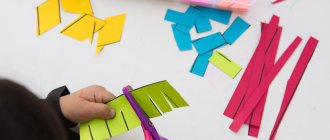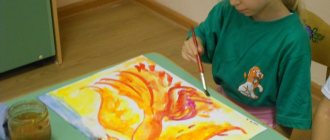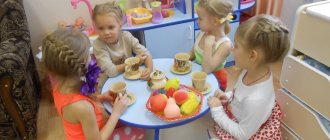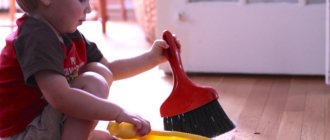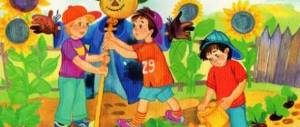Preview:
Construction game: “We are building a city and a village.”
Tasks:
To promote the improvement of skills in constructive activities,
Formulate a self-assessment of the final result,
Contribute to the creation of a positive emotional atmosphere,
Promote the development of coherent speech,
Carry out construction in a certain sequence,
Nurture collective relationships in the process of constructive activities.
instill patriotic feelings;
Equipment: building diagrams, attributes for construction.
Preliminary work: individual, subgroup, frontal work on the design of various buildings, construction of a city, village; familiarization with elementary mathematical concepts.
Sources: Program and technology “Kindergarten - a house of joy” by N.M. Krylova.
Progress of the lesson.
Round dance game "Cubs are playing ball."
V: Let's say hello
Motivation.
Q: Who do you think came first today?
Q: First... you came first today... Will this (doubt) be accurate? (I came first, there was no one else)
V.: It seems to me that you are second. (No, the first of the children)
V.: Why did I say that you are second?! (you can say this because you came first, and I came second)
V.: This is an inaccurate answer... In mathematics it is not allowed to count like this, the counting is inaccurate... When it can be said about us that there are TWO of us... or TWO (two people)
V.: So who is first today? (both you and me). The answer reflects an understanding of the problem.
V.: Today you and I can both call ourselves “first”... Only you will be the first... who? (Child) Yes, I will be the first (adult). And if I say that I am the first MAN, then you will?! (Second person - sounds like eureka, joyful).
V.: Go to the calendar and see if FIRST is there. (Today is December 1; December is the first month of winter, Monday is the first day of the week, January will be the first month of the year).
Q: What are the names of children who come to kindergarten? (Preschoolers)
Q: What will they call you when you go to school? (Pupils)
V.: There is this type of work - construction. What professions are people called builders? (called).
V.: Do we have building material... Can we be builders?! (Can )
Q: Where do you want to build? What material…? What are you planning? So, what happens (strangely) that every builder builds wherever he wants?! (Children must understand that a builder, like any other profession, depends on the plans of the architect, and their plans depend on the conditions of the area).
Q: Have you chosen WHAT you want to build? And who was missing so that your results of labor... and bridges, and houses, and roads, and factories would benefit people and be convenient for them?! (You need an architect..., he plans a city or a village...).
Q: But before building, what should he do? Choose a location. So, the main FIRST in construction will be the architect?!
V.: Well, in order for all the buildings and structures to be distributed, the architect needs to draw everything on the board.
V.: So, who were we yesterday? (architects)
Q: What professions of builders will we have? (Bridge builders, road builders, house builders... And we also need to build a station... And a factory... We will build a village... And we will build a dairy plant in the city).
Q:Can you come up with a game about what is drawn on the board?
V.: So, what are we up to today? (build a city and a village)
V.: Can you build it so that everyone can live comfortably, so that
the buildings were STRONG, WARM, SO THAT IT WAS COMFORTABLE... (excitingly)? (Yes ).
V.: You agree too quickly (jokingly), but can you (excitingly) build such a city?! (Can ).
V.: Probably, we need to think not only about how beautiful the city and village will be, but also where we will place them.?!
V.: Well (thinking) you can build according to the plan, like, for example, St. Petersburg was built... Or you can build it like Moscow was built... It wasn’t built all at once, but gradually... There was no plan for the layout of the streets in advance, they built around the Kremlin .
Q: How did you and I decide to build? (According to plan).
V.: In our city there is a main square, from it there is a main street. There is an entrance and a train station. Will there be a river? This is the river...
Q: YOU are architects and builders, you have individual projects, please choose.
V.: And I say: “The city will be founded here, according to this plan.”
Activity.
Grade. Built.
V.: Construction time has expired. Let's discuss the development of the city and countryside? You probably agree that it’s good for the city and village to be beautiful, comfortable, and, of course, for the buildings to be durable? (Yes)
Everyone gathered for the assessment.
Q: What country do we live in? (Russia)
Q: What are those who live in Russia called? (Russians)
Q: What city do we live in? (Kemerovo)
Q: What is the name of the city that you built? (Suggest titles)
Q: The city that you built is in what country? (In Russia )
V.: Excuse me, how to determine this? (There is a flag on the main building of the city)
Q: What else can be a symbol of the state? (Coat of arms, anthem)
(Play Russian anthem)
Q: Is it convenient for residents to live in your city? Why? (Explain).
V.: Well, so your residents only relax, but they have nowhere to work?!
Are everyone unemployed? (There is a plant).
V.: Well, if there is a plant, then, probably, someone works at the plant, which means there is a result of the work?! (They will begin to fantasize about what they produced at the factory).
Q: Where do the raw materials for the plant come from? (
Q: Where are the products sent and to whom?! Should I send it far or close?! (They reason).
Q: How should it be sent..., what transport...? It is possible, of course, by river transport, but also by rail. ., maybe by plane...?! (They argue, if they call it river transport)
Q: Do you have piers? (No, but then you can by plane).
Q: Is there an airfield? (They reason).
Q: You had everything in the stores... both vegetables and fruits? (Yes).
V.: And they just lie in the store... and don’t run out?! (They are transported). On what?
Q: Where are they unloaded? (Future buildings are called again).
V.: They took it out... and they will bring it to you... From where? (Showing village houses)
Q: Did you bring anything from there? (Called)
Q: What could be sent there from your city?
(Yes, they probably need both scythes and tractors...).
V.: Well done! You are real builders!
Those who complete the conversation either play in the built city or look at books. But most will strive to play. It will take the form of a director's play. Children will talk about nesting dolls (of different sizes), take them to shops, theaters, schools, etc. Obviously, children will be happy to play with city buildings, roads, take nesting dolls to the theater, to the store...
APPLICATION
Construction game for older preschoolers
Description of material:
This game is intended for children of older preschool age. Children learn to cooperate in the process of collective constructive activity. Gain additional knowledge about the infrastructure of cities and villages. Based on the program N.M. Krylova "Kindergarten - a house of joy."
Construction game: "Town and Country".
Goal:
promoting the improvement of skills in constructive activities.
Objectives:
to promote the formulation of self-esteem of the final result, to promote the creation of a positive emotional atmosphere, to promote the development of coherent speech, to develop the ability to carry out construction in a certain sequence, taking into account the plan-scheme, to cultivate collective relationships in the process of constructive creative activity. instill patriotic feelings, consolidate children’s knowledge about the symbols of the state; Equipment: building diagrams, design attributes, constructor. Preliminary work: individual, subgroup, frontal work on the design of various buildings, construction of a city, village; familiarization with elementary mathematical concepts. Sources: Program and technology “Kindergarten - a house of joy” by N.M. Krylova.
Progress of the lesson
V.: Let's say hello Round dance game “A boat is sailing on the river” (own creativity)
A boat is sailing on the river And we are walking hand in hand (walking in a circle) And the rivers are a blue stream (showing waves) And there is a bridge across the river (join hands, elbows higher) And behind the bridge there are houses (hands above heads) And in those houses there are children are sleeping (palms under the cheek) Soon the sun will rise (hands up, stretch) The rooster will sing the song “Peek-a-boo” And all the kids will stand here (walk in a circle) And together they will run to the kindergarten (run) - Everyone... ran to the kindergarten !?!?
Motivation.
Q: What do they call children who come to kindergarten? (Preschoolers) Q: What will they call you when you go to school? (Schoolchildren) V.: There is this type of work - construction. What professions are people called builders? (called). V.: Do we have building material... Can we be builders?! (We can) What are we planning? So, what happens, every builder builds where he wants?! (No, according to the architect's plan). Q: Where do you want to build? What material…? Q: But before the builders get to work, what should the architect do? (Choose a place). So, the architect will be in charge of construction?! V.: That’s right, so that your results of labor... and bridges, and houses, and roads, and factories and plants bring benefits to people and would be convenient for them, you need an architect..., he plans a city or a village...). V.: Well, in order for all the buildings and structures to be distributed, the architect needs to draw everything on the board. Q: So, who were we yesterday? (architects). Why are you so sure? (because we were planning to build a city and a village, drawing a development plan) Q: And what did we think about today? (build a city and a village). So who will you be? (builders) Q: What professions of builders will we have? (Bridge builders, builders of high-rise buildings, house builders... And we also need to build a station... And the administration building... We will build a village.. V.: And you can build it so that everyone can live comfortably, so that the buildings are STRONG, WARM, SO THAT IT IS COMFORTABLE ... (Yes). V.: Can you build such a city?! (We can). V.: Probably, we need to think not only about how beautiful the city and village will be, but also where we will place them.?! On our convenient for the construction of a surface, on a plain, with a river flowing nearby... settlements have long appeared on the banks of rivers... V.: You can build according to a plan, as, for example, St. Petersburg was built... Or you can do it the way Moscow was built... It wasn’t built all at once, after all, but gradually... There was no plan for the layout of the streets in advance, they built around the Kremlin. Q.: How did you and I decide to build? (According to the plan). Q.: In our city there is a main square, the main street runs from it. There is a train station here V.: You are architects and builders, you have individual projects, please choose. (Children show the construction site on the diagram and take the required space). V.: We are starting the construction of the city and village according to our development plan. Activity. Grade. Built. V.: Construction time has expired. Let's discuss the development of the city and countryside? You probably agree that it’s good for the city and village to be beautiful, comfortable, and, of course, for the buildings to be durable? (Yes) While the children approach the teacher, you can offer to play a game, for example, “The Guilty Cloud.” Everyone gathered for the assessment. Q: What country do we live in? (Russia) Q: What are those who live in Russia called? (Russians) Q: What city do we live in? (Kemerovo) V.: What is the name of the city that you built? (They suggest names) Q: The city that you built is in what country? (In Russia) V.: Excuse me, how can this be determined? (There is a flag on the main building of the city) Q: What else can be a symbol of the state? (Coat of arms, anthem) Monog V.: Is it convenient for residents to live in your city? Why? (Explain). V.: Well, so your residents only relax, but they have nowhere to work?! Are everyone unemployed? (at the Factory) V.: Well, if there is a factory, then, probably, someone works at the factory, which means there is a result of the work?! (They will begin to fantasize about what they produced at the plant, for example, a wood processing plant) Q: Where do the raw materials for the plant come from? (Show village houses) V.: Where are the products sent and to whom?! (to consumers, to villages and cities) Q.: What should we use to send..., what transport...? By car, you can, of course, by river transport, or by rail, or by plane?! (They reason) Q: Do you have piers? (No, but it can be built). So let's include the construction of a pier and merchant ships in our future development plan. Q: Is there an airfield? (Next time the architect needs to add it to the construction plan). Q: Did you have everything in the stores... vegetables and fruits? (Yes). V.: And they just lie in the store... and don’t run out?! (They are transported). V.: From where? (Showing village houses) V.: What could be sent from your city to the village? (Ready baked goods, canned food, clothes...). V.: Well done! You are real builders!
- an important component in the upbringing and education of children. Therefore, first you need to consider some questions about constructive ones. I hope that the material I told will help you in teaching children.
What questions will we consider:
- What are constructive
- What does a child need for constructive play?
- Stages of development of constructive play
- Techniques for teaching constructive play
What it is? - this is a type where children reflect their impressions of surrounding objects, independently make various buildings, structures, buildings, roads, but do it in a schematic, generalized form. In constructive games, objects are replaced by other objects, that is, buildings are erected from special construction sets, building kits, and natural materials. That is why constructive games are classified as creative games. For children 3-5 years old, constructive games often take the form of role-playing games, in which children play the role of construction workers.
What does a child need for constructive play?
- The ability to create an image of an object in its spatial expression. This is how a sense of orientation in space develops, the ability to distinguish and establish the proportions and size of an object, its spatial relationships.
- The ability to evaluate and take into account the properties and quality of the materials used during construction, to anticipate and carry out a sequence of actions. Therefore, constructive games teach children to set goals and plan their actions.
- Constructive games develop in children the ability to compare and contrast the structure they created with the real objects on the basis of which the structure was built. This develops observation and attentiveness in children.
Stages of development of constructive play
- Children 3-5 years old depict single objects and small structures. The themes of their buildings are related to their role-playing games, for example, a garage for a car, a house for a doll. Their designs are very simple. Their buildings are arranged horizontally, like a drawing on paper. The same house for a doll is a certain space that is fenced off with several cubes, and on top there is some kind of plate or plank called a roof. Children at this age erect a building, then destroy it and begin to build it again. They are interested in the construction process itself, and not in the result obtained at the end of this activity. It often happens that construction is ahead of the plan: the child begins to build something, and only then recognizes some object in his construction.
- Children aged 5-7 years gradually expand the themes of buildings. They have ships, roads, bridges, buildings, cars. In their designs, children try to convey the originality of a particular structure. For example, they are building not just a house, but their own house in which they live or their own kindergarten. At this age they begin to complicate the structure itself. The buildings are growing upward. Children decorate them with columns, towers, windows, using various ceilings.
Techniques for teaching constructive play
Adults (parents and kindergarten teachers) should teach children constructive skills and abilities. Because without this, children's buildings will remain simple and primitive. There are several ways adults can teach children the skills needed for constructive play.
- Examination of objects, structures, buildings. During examination, it is necessary to draw children's attention to the purpose of the object, the features of its design, parts and their proportions. All this should be accompanied by a conversation with the children (namely a conversation, not a monologue by an adult). You can also additionally consider drawings of similar objects.
- The indirect guidance of an adult is the enrichment and updating of children’s knowledge about the objects and characteristics of the materials from which they build their buildings.
- Direct guidance is the role-playing participation of an adult in the game, explanations, and advice during the game.
Today we talked about constructive games
, about the skills that a child needs for them, about the stages of constructive development and about techniques for managing them.
If you have any additions on this issue, be sure to leave your comment.
